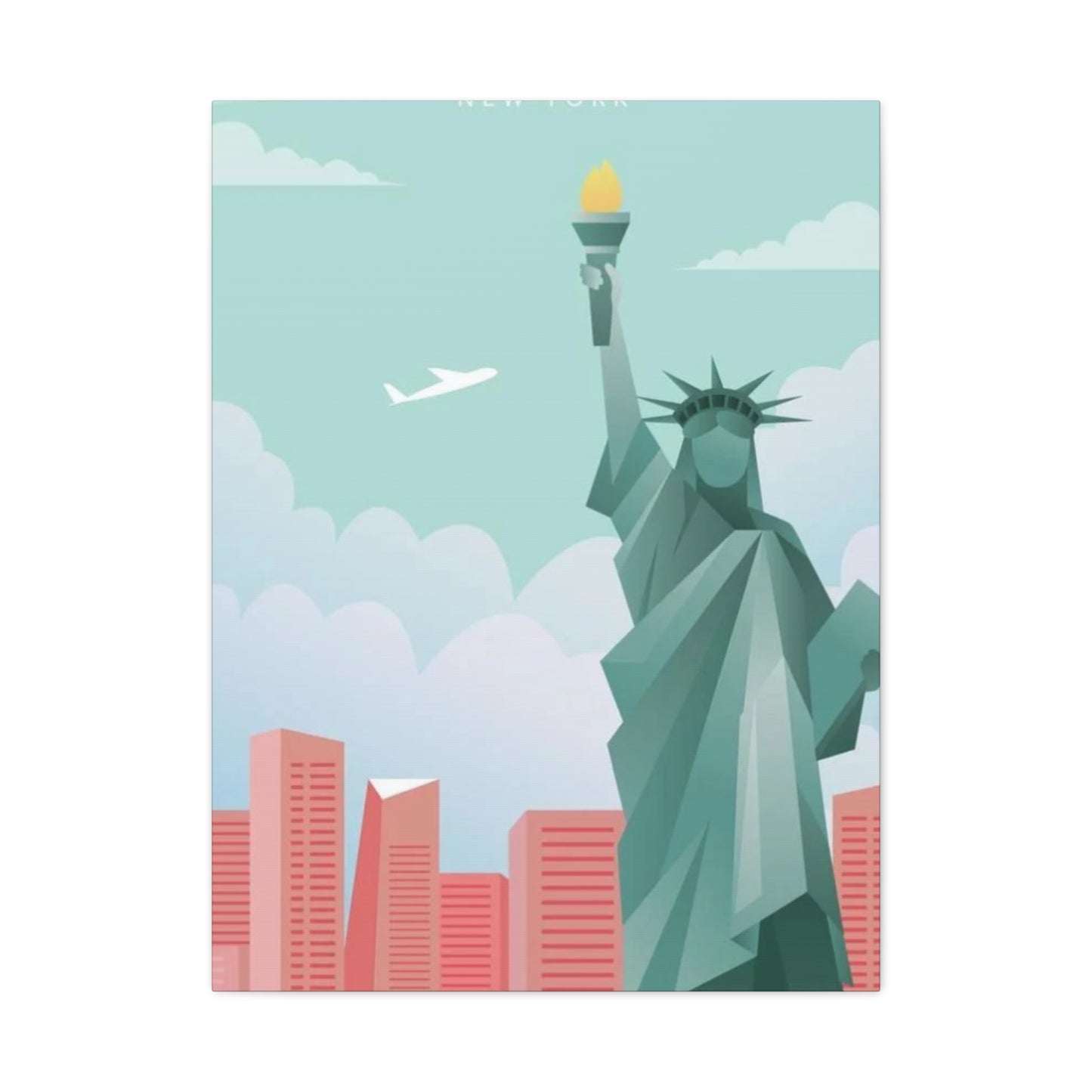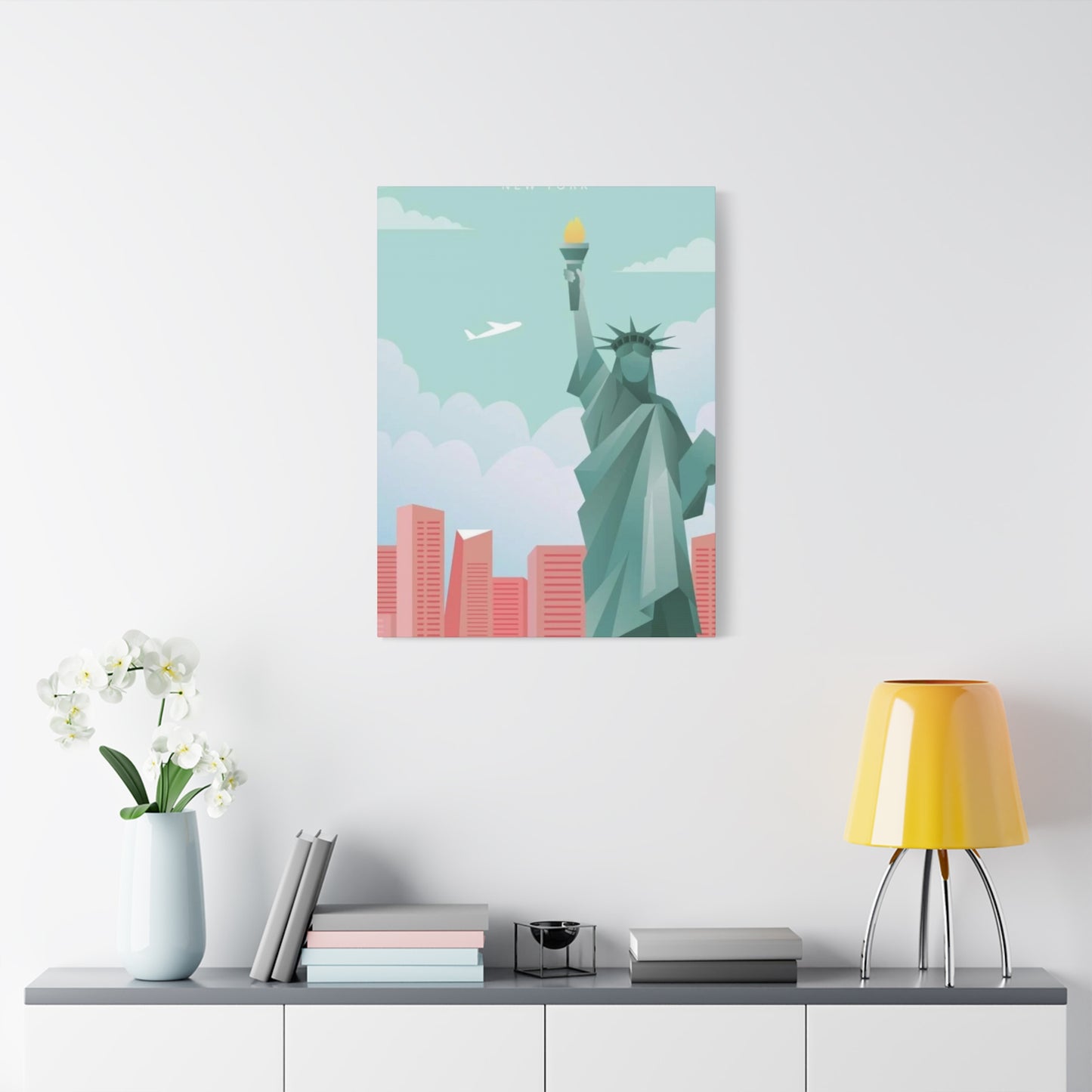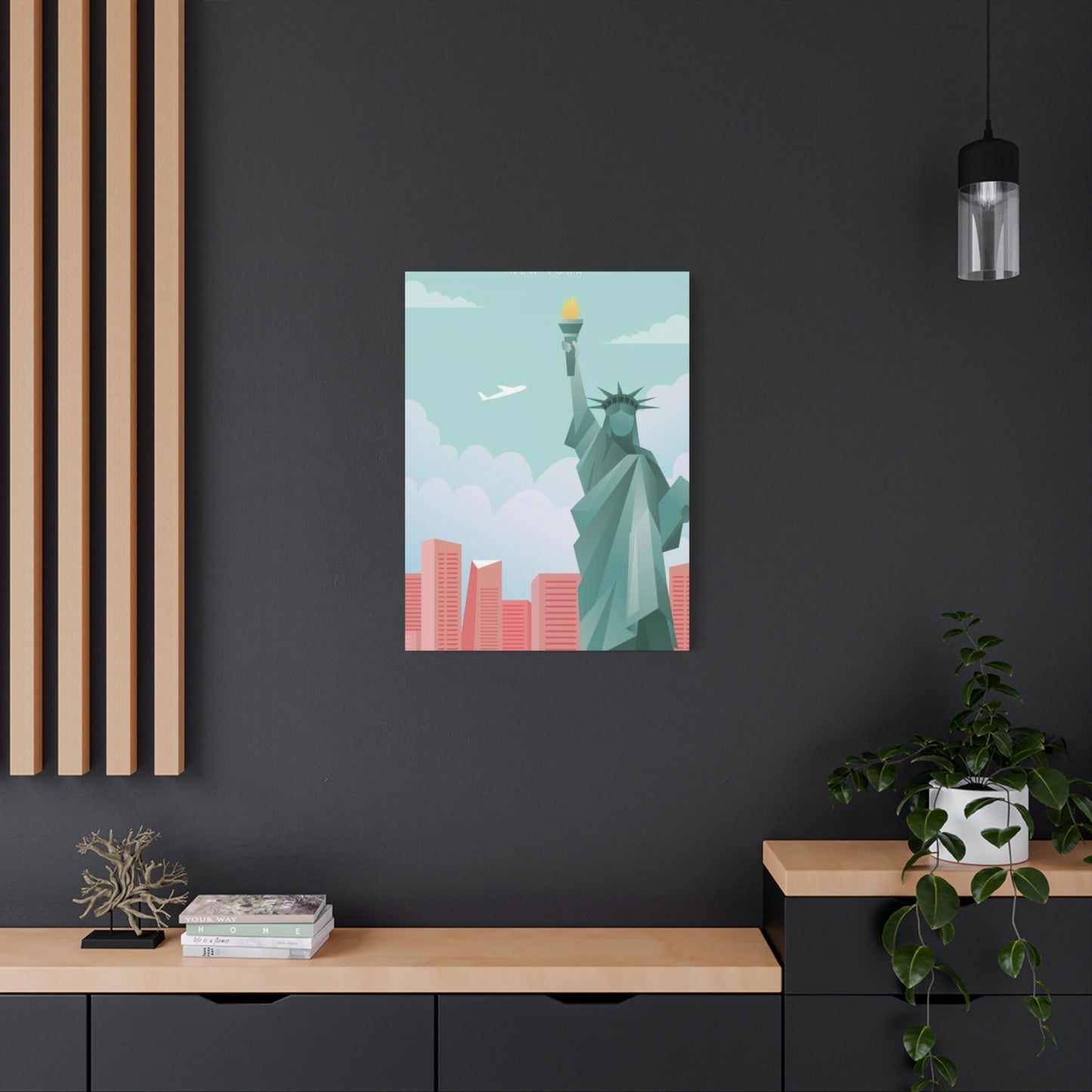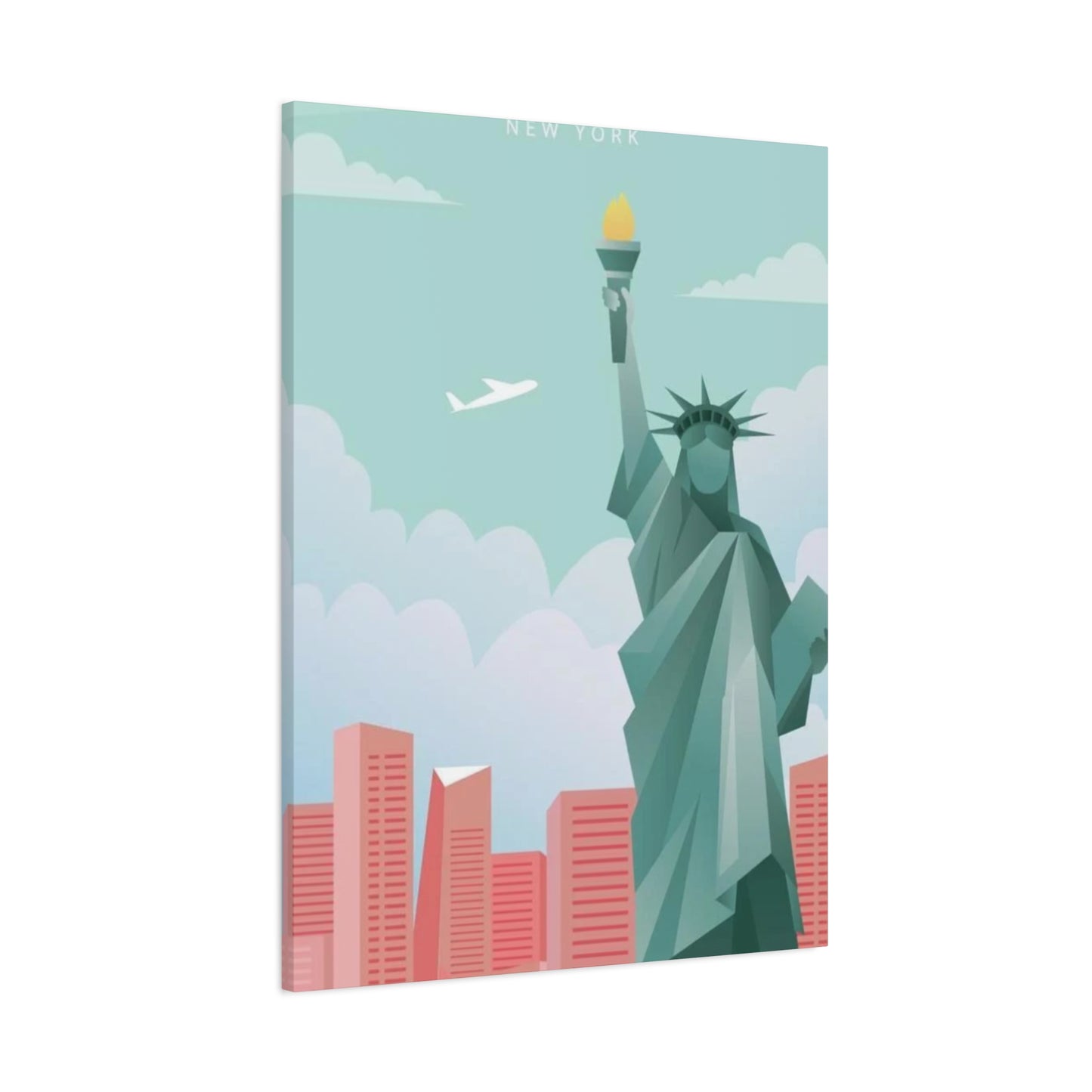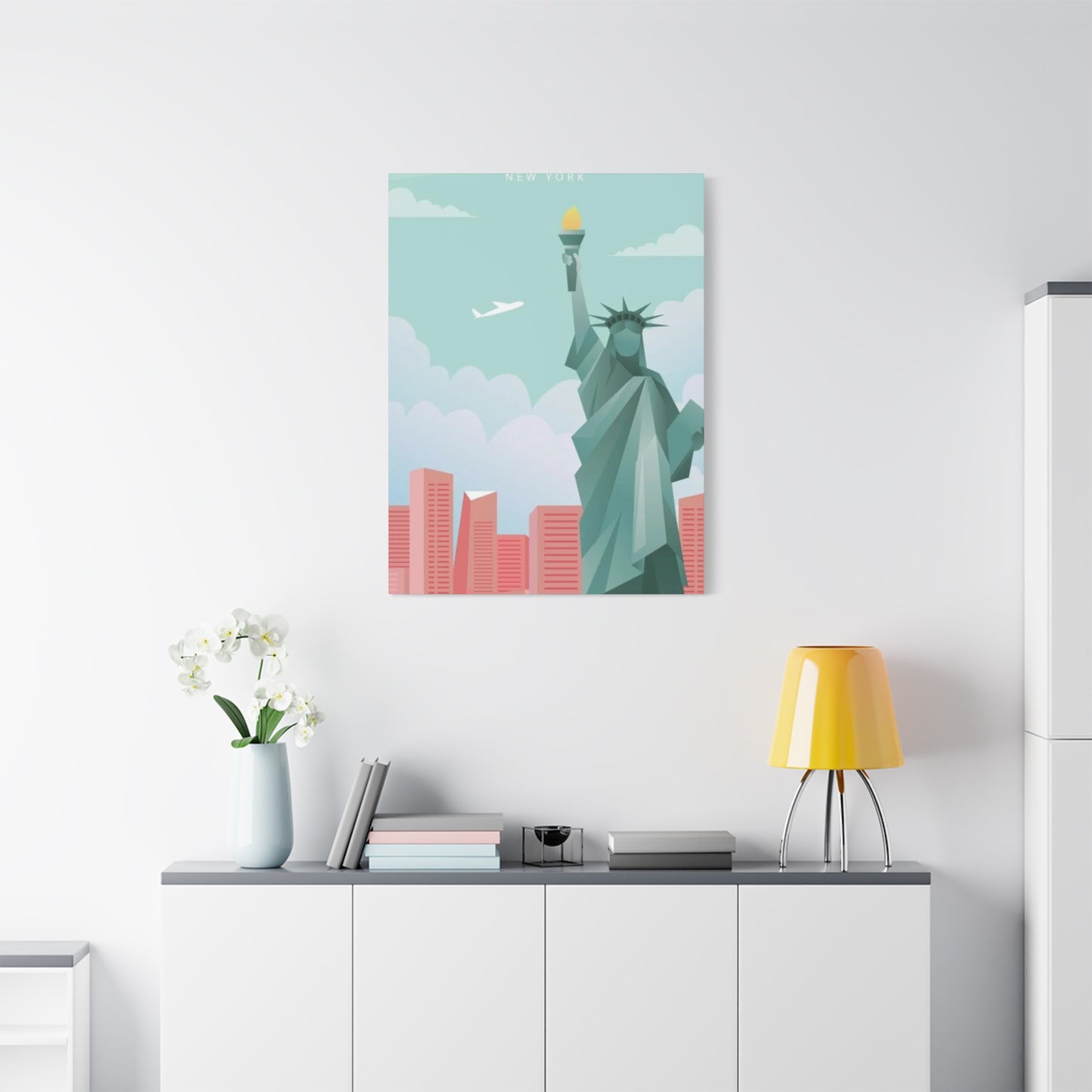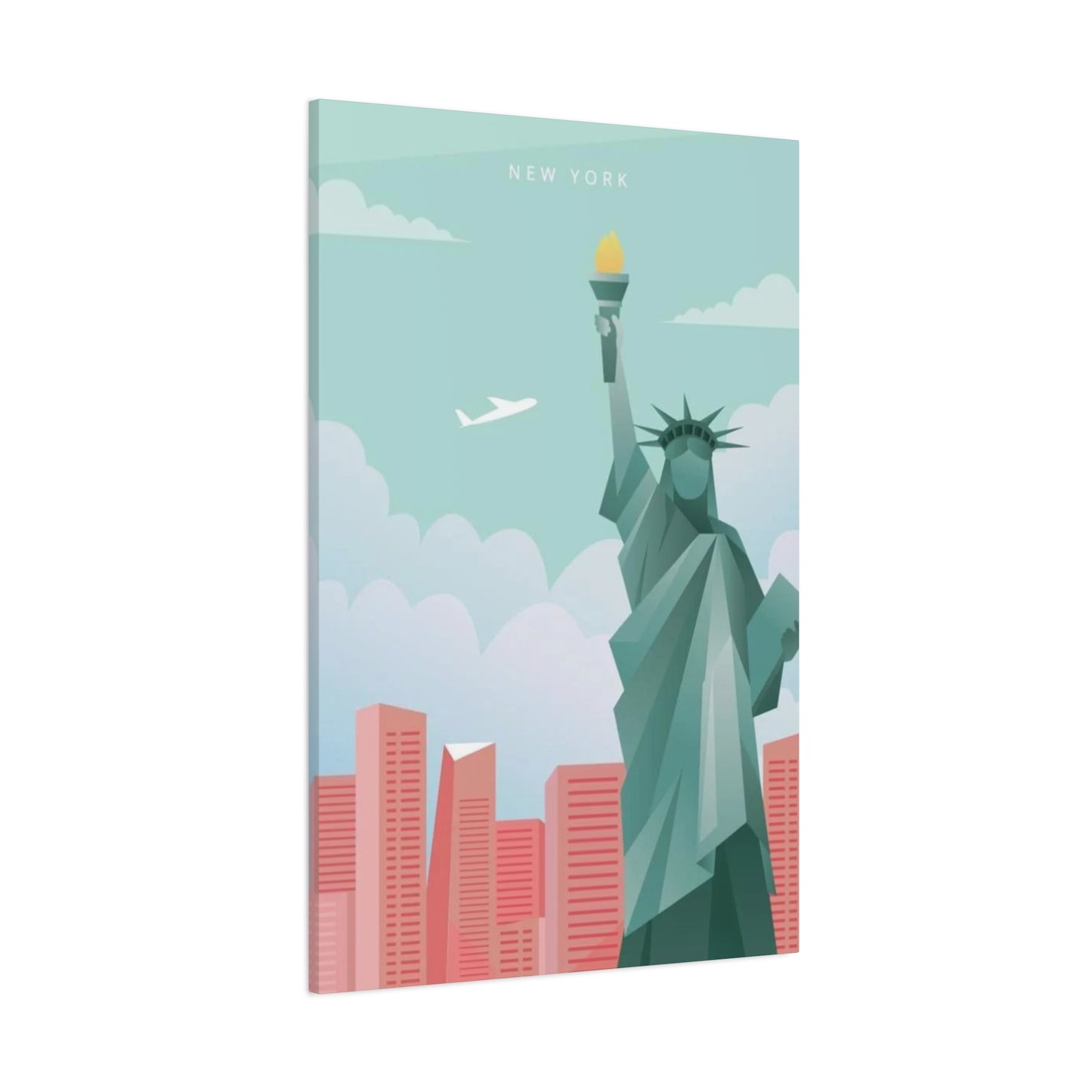Statue of Liberty in New York City Wall Art: Transform Your Space with Iconic American Symbolism
The Statue of Liberty stands as one of the most recognizable monuments on the planet, representing freedom, democracy, and the American dream. This colossal neoclassical sculpture has inspired countless artists, designers, and home decorators to incorporate its majestic imagery into wall art pieces that bring sophistication and cultural significance to any space. Whether you're looking to celebrate American heritage, create a focal point in your living room, or add metropolitan charm to your office, statue of liberty wall art offers endless possibilities for transforming your environment.
The Enduring Appeal of Lady Liberty in Home Decor
Lady Liberty has captivated people's imaginations since her dedication in 1886. Standing at 305 feet from ground to torch, this copper statue gifted by France has become synonymous with New York City's skyline and American values. The monument's powerful symbolism translates beautifully into wall art, making it a popular choice for residential and commercial spaces alike. When you choose statue of liberty in new york city wall art, you're not just selecting a decorative piece but embracing a narrative of hope, freedom, and opportunity that resonates across generations.
The visual impact of this iconic monument in art form creates an immediate connection to one of the world's most vibrant cities. The statue's crown with seven spikes representing the seven continents and oceans, her uplifted torch symbolizing enlightenment, and the tablet inscribed with the date of American independence all contribute to rich visual storytelling that enhances any interior design scheme. Modern interpretations range from photographic prints capturing the statue's weathered patina to abstract representations using bold colors and contemporary techniques.
Interior designers frequently recommend incorporating landmark imagery to establish a sense of place and character within a room. The statue of liberty serves this purpose exceptionally well, instantly evoking the energy and diversity of New York City while maintaining universal appeal. Whether rendered in classic sepia tones reminiscent of vintage postcards or vibrant pop art colors that energize contemporary spaces, this monument adapts seamlessly to various aesthetic preferences and design philosophies.
Diverse Styles and Mediums for Liberty Artwork
The versatility of statue of liberty wall art manifests in the incredible variety of styles and mediums available to collectors and decorators. Photography enthusiasts can find stunning captures of the monument at different times of day, from sunrise shots with golden light illuminating her torch to dramatic nighttime images where she stands illuminated against the dark Manhattan skyline. These photographic pieces often showcase the statue from unique angles, including aerial views that reveal her star-shaped base or close-ups highlighting the intricate details of her crown and facial features.
Canvas prints remain among the most popular formats for displaying Lady Liberty artwork. The texture of canvas lends itself beautifully to both photographic reproductions and painted interpretations, creating depth and visual interest that flat paper prints cannot match. Many artists create multi-panel canvas arrangements, known as triptychs or polyptychs, that present the statue across several connected pieces, allowing for dramatic large-scale installations that command attention in spacious rooms or along extended wall sections.
Metal prints have emerged as a contemporary option for statue of liberty artwork, offering sleek modernity and exceptional durability. The process of infusing dyes directly onto specially coated aluminum creates luminous colors and sharp details that make the monument appear almost three-dimensional. These metal pieces work particularly well in modern or industrial-styled spaces, complementing stainless steel appliances, concrete surfaces, and minimalist furniture with their crisp, contemporary aesthetic.
Vintage-style prints appeal to those seeking nostalgic charm and historical authenticity. Artists recreate the appearance of aged photographs, travel posters, and postcards from the early twentieth century, complete with faded colors, worn edges, and period-appropriate typography. These pieces evoke the immigrant experience and the statue's role as a welcoming beacon to millions arriving at Ellis Island, adding layers of meaning beyond mere decoration.
Abstract and pop art interpretations inject energy and contemporary relevance into traditional monument imagery. Artists employ techniques like screen printing, collage, mixed media, and digital manipulation to reimagine Lady Liberty in unexpected ways. Bold color palettes featuring electric blues, vibrant magentas, and neon greens transform the familiar silhouette into striking modern art that appeals to collectors seeking statement pieces that spark conversation.
Selecting the Perfect Size and Placement
Choosing the appropriate size for your statue of liberty in new york city wall art requires careful consideration of your space's dimensions and the visual impact you wish to create. Small to medium pieces measuring between twelve and thirty inches work beautifully in intimate settings like home offices, bedrooms, or as part of gallery walls where multiple artworks create a curated collection. These sizes allow the artwork to contribute to the overall aesthetic without overwhelming other design elements or competing with furniture and accessories.
Large-scale pieces ranging from three to six feet become commanding focal points that anchor entire rooms. Placing an oversized statue of liberty canvas above a sofa in your living room immediately draws the eye and establishes the space's thematic direction. Similarly, positioning a substantial piece in an entryway creates an impressive first impression for guests while setting expectations for the home's style and the homeowner's interests. When selecting larger pieces, ensure adequate wall space surrounds the artwork, typically leaving at least six to twelve inches of empty wall on all sides to prevent a cramped appearance.
Extra-large installations exceeding six feet suit commercial spaces, large open-concept homes, and areas with high ceilings where smaller pieces would appear lost or insignificant. Hotels, restaurants, corporate offices, and retail establishments frequently commission or purchase monumental statue of liberty wall art to reinforce location-based branding, especially businesses wanting to emphasize their New York connections or American identity. These impressive pieces often span multiple panels, creating visual continuity across extensive wall surfaces.
Height placement significantly affects how viewers experience and interact with artwork. The general rule suggests hanging pieces so the center sits at eye level, typically between fifty-seven and sixty inches from the floor. However, when artwork hangs above furniture, maintain approximately six to twelve inches between the furniture's top and the artwork's bottom edge, ensuring visual connection between elements while preventing the piece from appearing to float awkwardly on the wall.
Consider the room's natural lighting when positioning statue of liberty wall art. Direct sunlight can fade pigments over time, particularly in photographic prints and works on paper. If your preferred location receives strong natural light, opt for UV-protected glass or acrylic glazing, or choose more light-stable mediums like metal prints. Alternatively, position the artwork on walls perpendicular to windows rather than directly opposite them, allowing natural light to illuminate the piece without causing long-term damage.
Color Schemes and Coordinating Your Decor
The color palette of your chosen statue of liberty artwork should harmonize with your existing interior design while potentially introducing new accent colors that refresh the space. Traditional representations typically feature the statue's characteristic green patina against blue skies or the gray tones of New York Harbor. These natural color combinations work seamlessly with neutral decorating schemes incorporating whites, grays, taupes, and beiges, allowing the artwork to integrate smoothly without clashing with surrounding elements.
Black and white statue of liberty prints offer timeless sophistication and unmatched versatility. The absence of color ensures these pieces complement virtually any palette while adding visual interest through contrast, texture, and composition. Monochromatic artwork proves particularly valuable in spaces where you want flexibility to change accent colors seasonally or as trends evolve, as the artwork remains compatible regardless of whether you introduce coral pillows, emerald throws, or sapphire vases.
Sepia-toned and vintage-style pieces introduce warm browns, creams, and aged yellows that pair beautifully with traditional and transitional interiors. These earthy tones complement wood furniture, leather upholstery, and classic fabrics like damask or toile. The nostalgic quality of sepia imagery enhances spaces decorated with antique accessories, creating cohesive visual narratives that honor historical design traditions.
Contemporary and pop art interpretations employing vivid, unconventional colors require more deliberate coordination but can produce spectacular results. If your statue of liberty wall art features electric blue, hot pink, or vibrant orange, echo these bold hues in small doses throughout the room through accessories like throw pillows, area rugs, or decorative objects. This technique, called color bridging, creates intentional connections between the artwork and the space, making the piece feel integrated rather than arbitrarily placed.
Metallic accents within the artwork, whether gold leaf details, silver screen printing, or bronze tones, provide opportunities to coordinate with hardware, light fixtures, and decorative accessories. A statue of liberty piece featuring gold elements might inspire you to incorporate brass candlesticks, gold-framed mirrors, or fixtures with warm metallic finishes, creating a cohesive luxurious atmosphere that elevates the entire space.
Materials and Quality Considerations
Understanding the materials and production methods used in statue of liberty in new york city wall art helps you make informed purchasing decisions that balance aesthetic preferences with practical considerations like durability, maintenance, and budget. Canvas remains the most popular substrate for reproduction artwork due to its texture, flexibility, and professional appearance. Gallery-wrapped canvas, where the print extends around the sides of the stretcher bars, creates a finished look that typically doesn't require framing, reducing costs and simplifying installation.
The printing technology employed significantly impacts image quality and longevity. Giclée printing, which uses archival-quality inks and high-resolution digital files, produces museum-quality reproductions with exceptional color accuracy and detail. These prints resist fading for decades when properly displayed, making them worthwhile investments for serious collectors. Less expensive digital printing methods may offer lower initial costs but can show color degradation within just a few years, particularly when exposed to light.
Paper prints require framing under glass or acrylic for protection against moisture, dust, and handling damage. The paper quality varies considerably, from standard posters printed on lightweight stock to fine art papers with cotton content and archival properties. When selecting framed prints, examine the matting and framing materials as well. Acid-free mats prevent yellowing and deterioration, while UV-protective glazing shields the print from harmful light exposure that accelerates fading.
Metal prints offer exceptional durability and unique visual properties that make colors appear luminous and details remarkably sharp. The aluminum substrate resists warping, doesn't require glass, and cleans easily with a soft cloth, making these pieces low-maintenance options for high-traffic areas or homes with children and pets. The modern aesthetic of metal prints complements contemporary interiors while the lightweight construction simplifies hanging and reduces stress on walls.
Wood-mounted prints combine rustic charm with contemporary printing techniques, creating pieces that work beautifully in farmhouse, industrial, and eclectic spaces. The natural wood grain visible around print edges adds organic texture and warmth, while the rigid substrate ensures the image remains flat and professional-looking. Some artists enhance wood-mounted pieces with hand-applied finishes or edge treatments that emphasize the handcrafted quality.
Acrylic face-mounted prints represent the premium end of the market, featuring photographs or artwork sandwiched between acrylic sheets that create incredible depth and vibrant color saturation. The glossy surface produces a contemporary gallery aesthetic, and the substantial weight conveys quality and permanence. These pieces command attention in modern and luxury interiors where cutting-edge presentation matches the sophistication of the overall design scheme.
Framing Options to Enhance Your Artwork
Selecting the right frame for your statue of liberty wall art substantially impacts its visual effect and how well it integrates with your interior design. Traditional wood frames in dark finishes like espresso, walnut, or black create classic elegance that works across various decorating styles. The substantial presence of wood framing lends importance to the artwork, making it feel like a curated piece worthy of attention and contemplation.
Lighter wood tones including natural oak, maple, and whitewashed finishes contribute casual approachability and work particularly well in coastal, Scandinavian, and farmhouse-inspired interiors. These frames prevent artwork from feeling too formal or imposing, allowing the statue of liberty imagery to feel welcoming and accessible rather than austere or intimidating. The natural variations in wood grain add subtle visual interest that complements rather than competes with the artwork.
Metal frames deliver contemporary sophistication in finishes ranging from brushed aluminum and stainless steel to black iron and brass. The clean lines and slim profiles of metal framing keep focus on the artwork while providing necessary structure and protection. These frames excel in modern, industrial, and minimalist spaces where ornate detailing would conflict with the overall aesthetic philosophy.
Ornate frames featuring carved details, gilded finishes, or decorative corner elements suit traditional and maximalist interiors where embellishment enhances rather than detracts. When pairing statue of liberty artwork with elaborate framing, ensure the frame's style period aligns with the artwork's interpretation. Vintage-style prints might warrant antique gold frames with baroque detailing, while formal photographic pieces could pair with more restrained traditional frames featuring subtle decorative elements.
Floating frames create the illusion that artwork hovers within the frame, with visible space between the image and the inner frame edge. This contemporary presentation technique works beautifully with canvas and wood-mounted pieces, adding dimension and visual intrigue. The shadow created by the gap between artwork and frame adds depth that makes the piece more dynamic and engaging.
Frameless presentations suit certain artwork types and interior styles perfectly. Gallery-wrapped canvas doesn't require framing, and the extended image wrapping around the sides creates a three-dimensional object rather than a flat picture. Similarly, metal and acrylic prints often look best without frames, as these mediums possess inherent structural integrity and contemporary appeal that framing might diminish.
Creating Gallery Walls with Liberty Themes
Gallery walls offer creative opportunities to incorporate statue of liberty in new york city wall art within larger curated collections that tell visual stories and express personal style. The key to successful gallery walls lies in balancing variety with cohesion, selecting pieces that share enough common elements to feel intentionally grouped while introducing sufficient diversity to maintain visual interest and prevent monotony.
When building a gallery wall around Lady Liberty imagery, consider incorporating complementary New York City landmarks and scenes. Artwork featuring the Brooklyn Bridge, Manhattan skyline, Central Park, or Empire State Building creates thematic continuity that celebrates the city's iconic architecture and landscapes. This approach works particularly well for New York enthusiasts, travelers reminiscing about visits, or anyone drawn to urban sophistication.
Mixing different mediums and formats within your gallery wall adds textural variety and visual dynamism. Combine framed photographs with canvas prints, metal pieces with vintage posters, and perhaps three-dimensional elements like shadow boxes containing miniature statue replicas or related memorabilia. The interplay between flat and dimensional elements, glossy and matte surfaces, and framed and frameless pieces creates engaging complexity that rewards extended viewing.
Color coordination across gallery wall elements prevents the arrangement from appearing chaotic or haphazard. You might select pieces that all feature similar color palettes, perhaps various interpretations of Lady Liberty united by blue and green tones with white accents. Alternatively, anchor the collection with one or two colorful statement pieces while filling surrounding positions with black and white or sepia-toned images that provide visual rest and prevent color overload.
Size variation adds rhythm and prevents the rigid appearance that identical frames create. Mix large anchor pieces with medium-sized supporting elements and small accent pieces, arranging them so visual weight distributes evenly across the entire wall section. Large pieces typically occupy corners or central positions, with smaller elements arranged around them in balanced configurations that feel natural rather than forced.
Planning gallery wall layouts before installing anything saves frustration and wall damage. Create paper templates matching each artwork's dimensions and arrange them on the floor until you achieve a pleasing configuration, or use painter's tape directly on the wall to visualize the arrangement. Many designers recommend maintaining consistent spacing between pieces, typically two to three inches, to create unity without cramping individual elements.
Themed Room Designs Featuring Lady Liberty
Building entire room designs around statue of liberty wall art allows you to create immersive environments that transport occupants to New York City or celebrate American heritage comprehensively. A New York-themed room might incorporate not only Lady Liberty artwork but also subway tile in the kitchen or bathroom, industrial-style lighting fixtures reminiscent of loft apartments, exposed brick or brick-pattern wallpaper, and furnishings with urban edge like leather sofas and metal-framed tables.
Color schemes inspired by the statue and its surroundings can guide your material and finish selections throughout the space. The statue's weathered copper patina in shades of seafoam green and verdigris pairs beautifully with navy blues echoing New York Harbor, gray tones reflecting city architecture, and white accents suggesting clouds and water spray. These colors create sophisticated, cohesive palettes that feel fresh and contemporary while honoring the monument's appearance.
Patriotic rooms centered on American symbolism use Lady Liberty as the cornerstone of designs incorporating traditional red, white, and blue color schemes, stars and stripes patterns, and memorabilia celebrating national heritage. This approach suits home offices, man caves, family rooms, or any space where expressing national pride and values feels appropriate. Balance overt patriotic elements with neutral foundations to prevent the space from feeling overwhelming or costume-like.
Travel-themed rooms celebrating world exploration and adventure benefit from statue of liberty artwork as an anchor representing one of the planet's most iconic destinations. Surround the Lady Liberty piece with maps, vintage luggage, globes, and artwork from other significant landmarks worldwide. This creates spaces that inspire wanderlust and commemorate meaningful journeys while displaying sophisticated visual storytelling.
Urban loft aesthetics naturally incorporate statue of liberty in new york city wall art as these design approaches celebrate metropolitan living and architectural heritage. Combine the artwork with industrial elements like exposed ductwork, concrete floors, steel beams, and factory-style windows. Furnishings might include repurposed factory carts as coffee tables, metal stools, and utilitarian shelving, all working together to evoke the converted warehouse spaces that define New York's most distinctive neighborhoods.
Office and professional spaces gain gravitas and cultural sophistication through thoughtfully placed Lady Liberty artwork. The monument's associations with American enterprise, opportunity, and achievement make it particularly appropriate for business environments. Select understated, professional presentations like black and white photography in simple frames rather than bold pop art interpretations, ensuring the artwork commands respect without distracting from work activities.
Photography Tips for Capturing Lady Liberty
Photography enthusiasts visiting New York City often want to capture their own images of the statue for personal wall art, creating unique pieces unavailable through commercial channels. Understanding optimal times, locations, and techniques for photographing this monument helps you create compelling images worthy of prominent display in your home.
Golden hour photography, the period shortly after sunrise or before sunset when sunlight takes on warm, soft qualities, produces the most flattering images of Lady Liberty. Morning light from the east illuminates her face beautifully while creating long shadows that add dimension. Evening light creates dramatic backlighting effects and can silhouette the statue against colorful skies, producing images with emotional impact and visual drama.
Location selection dramatically affects your photographic perspective and composition. Battery Park in Manhattan offers excellent views from the promenade, allowing you to photograph the statue from relatively close range against open sky. Liberty State Park in Jersey City provides unobstructed views with Manhattan's skyline visible behind the statue, creating layered compositions that emphasize the monument's relationship to the city. The Staten Island Ferry, which passes remarkably close to Liberty Island during its free twenty-five-minute journey, offers dynamic changing perspectives and opportunities to capture the statue from water level.
Equipment considerations influence image quality and creative possibilities. Wide-angle lenses capture the entire statue including its base and surroundings, creating context and environmental portraits. Telephoto lenses compress perspective and allow detailed close-ups of the statue's face, torch, and crown, producing intimate images that reveal textures and details invisible to the naked eye from shore. Tripods stabilize cameras during low-light conditions at dawn or dusk, preventing blur from camera shake and enabling longer exposures that capture motion in clouds or water.
Composition techniques like the rule of thirds, where you position the statue off-center at imaginary grid intersections, create more dynamic images than centering the subject. Including foreground elements like tree branches, architectural features, or people adds depth and scale, helping viewers understand the monument's massive dimensions. Leading lines formed by shorelines, piers, or pathways guide the viewer's eye toward Lady Liberty, creating visual flow through the image.
Weather conditions present creative opportunities beyond standard blue-sky photography. Dramatic storm clouds create moody, atmospheric images with emotional weight and visual tension. Fog partially obscuring the statue adds mystery and can produce striking minimalist compositions where the monument emerges from white emptiness. Rare snow events transform the statue and harbor into winter wonderlands, offering unique seasonal imagery that stands apart from typical representations.
Post-processing techniques enhance raw images and help achieve specific aesthetic goals. Black and white conversions emphasize form, texture, and contrast while removing potentially distracting color elements. Vintage processing with faded colors, vignetting, and grain effects creates nostalgic pieces mimicking historical photographs. HDR processing captures the full range of tones from bright sky to shadowed statue details, though restraint prevents unrealistic oversaturated results that appear artificial.
The Symbolism and Meaning Behind the Statue
Understanding the rich symbolism embedded in Lady Liberty's design adds depth to your appreciation of statue of liberty wall art and helps you explain the significance of your chosen pieces to guests and family. French sculptor Frédéric Auguste Bartholdi designed every element with intentional meaning that remains relevant nearly one hundred forty years after the statue's dedication.
The torch held aloft in Lady Liberty's right hand represents enlightenment, illuminating the path to liberty and showing the way toward freedom, knowledge, and reason. This powerful symbol suggests that freedom requires not just political independence but intellectual development and educational opportunity. When you display statue of liberty in new york city wall art prominently, you embrace these values and signal commitment to learning, progress, and enlightened thinking.
The tablet clutched in her left hand bears the date July 4, 1776, in Roman numerals, commemorating American independence from British rule. This explicit reference to the nation's founding connects the statue directly to revolutionary ideals and the ongoing American experiment in self-governance. The rectangular tablet recalls ancient law tablets, suggesting that freedom exists within a framework of justice and legal protections rather than lawless chaos.
The crown features seven spikes representing rays of light, with most interpretations suggesting these symbolize the seven continents and seven seas, indicating that liberty should extend universally across all lands and peoples. This global perspective elevates the statue beyond merely American symbolism, positioning freedom as a universal human aspiration transcending national boundaries. Alternative interpretations suggest the seven rays represent the seven heavens or the seven days of creation, adding spiritual dimensions to the monument's meaning.
Broken chains and shackles lie at Lady Liberty's feet, though these remain difficult to see from ground level and often go unnoticed by casual observers. These powerful symbols represent freedom from oppression and the breaking of bonds that restrict human potential. The chains reference both slavery's abolition and humanity's broader liberation from tyrannical systems, making the monument a powerful statement against all forms of domination and subjugation.
The statue faces southeast toward the Atlantic Ocean, greeting ships arriving from Europe and symbolically welcoming immigrants seeking new opportunities. This orientation made Lady Liberty the first glimpse of America for millions of immigrants arriving at nearby Ellis Island between 1892 and 1954. For these newcomers, the statue represented hope, refuge, and the promise of better lives, cementing its association with immigration and the American dream in the national consciousness.
Caring for and Maintaining Your Wall Art
Proper care and maintenance ensure your statue of liberty wall art retains its beauty and value for decades, protecting your investment while preserving the visual impact that initially attracted you to the piece. Different materials require specific approaches, so understanding your artwork's construction guides appropriate care practices.
Canvas prints benefit from gentle dusting with soft, dry cloths or feather dusters that remove surface debris without abrading the print or canvas texture. Avoid liquid cleaners, which can penetrate the canvas and damage inks or cause warping. If canvas develops minor wrinkles or looseness, placing the artwork face-down on a clean surface and lightly misting the back with water can cause the canvas to shrink and tighten as it dries, though this technique requires caution to prevent over-wetting.
Framed works under glass require careful cleaning to maintain clarity without scratching the protective glazing. Use glass cleaners specifically formulated for fine art or simple solutions of distilled water with small amounts of white vinegar. Apply cleaning solution to your cloth rather than directly onto the glass to prevent liquid from seeping between the glass and matting. Microfiber cloths clean effectively without leaving lint or causing scratches that accumulate over time and cloud the glass.
Metal prints clean easily with soft, slightly damp cloths, making them ideal for homes with children, pets, or high dust levels. The durable surface resists fingerprints and smudges better than glass, though you should still handle pieces by their edges during cleaning. Avoid abrasive cleaners or rough cloths that might scratch the specially coated surface where the image resides. The exceptional durability of metal prints makes them suitable for bathrooms, kitchens, and other moisture-prone environments where paper-based artwork would deteriorate.
Acrylic-mounted pieces clean similarly to framed works under glass, though you should verify whether the acrylic is treated with anti-reflective or anti-static coatings that require specific cleaning products. These premium pieces often come with manufacturer care instructions that should be followed carefully to preserve special surface treatments that enhance appearance and longevity.
Environmental factors significantly impact artwork lifespan regardless of medium. Humidity control prevents mold growth, warping, and adhesive failure that can cause artwork to separate from substrates. Ideal relative humidity for artwork storage and display ranges from forty to fifty percent, achievable in most climates with dehumidifiers or humidifiers depending on seasonal conditions. Temperature stability matters as well, with rapid fluctuations causing expansion and contraction that stresses materials and connections over time.
Light exposure causes the most common and preventable damage to wall art, with ultraviolet radiation breaking down pigments and causing irreversible fading. Position artwork away from direct sunlight, or use window treatments that filter UV rays while allowing natural light to enter spaces. Consider rotating pieces seasonally between high-light and low-light locations, distributing exposure across your collection rather than allowing a few prized pieces to bear the brunt of light damage. When installing new lighting to illuminate artwork, select LED bulbs with low UV output rather than halogen or incandescent options that emit damaging radiation along with visible light.
Commercial and Office Applications
Businesses leverage statue of liberty in new york city wall art to communicate brand values, establish location-based identity, and create memorable environments that leave lasting impressions on clients, customers, and employees. The strategic placement of iconic imagery serves marketing and branding objectives while enhancing workplace aesthetics and potentially improving employee satisfaction and productivity.
Hotels in New York City and across the country use Lady Liberty artwork to immediately communicate their connection to the iconic destination, whether they operate in Manhattan or simply want to evoke metropolitan sophistication. Lobbies, guest rooms, meeting spaces, and restaurants within hotels benefit from cohesive theming built around recognizable landmarks that help guests feel immersed in place and atmosphere. Large-scale installations in common areas create photo opportunities that guests share on social media, providing free marketing exposure while reinforcing brand identity.
Restaurants and bars with American, New York, or urban themes incorporate statue of liberty wall art as essential design elements that support their culinary concepts and target demographics. A New York-style pizza restaurant might display vintage Lady Liberty posters alongside images of Brooklyn's streets and classic yellow taxis, creating immersive environments that transport diners to the city regardless of the restaurant's actual location. Upscale establishments might choose elegant black and white photography or sophisticated abstract interpretations that add visual interest without overwhelming refined interiors.
Corporate offices benefit from Lady Liberty imagery when company values align with the monument's symbolic associations. Law firms, financial institutions, and consulting companies often incorporate American symbols to convey trustworthiness, stability, and alignment with national interests. The statue's representation of justice, enlightenment, and opportunity resonates in professional contexts, adding gravitas to reception areas, conference rooms, and executive offices. When clients visit these spaces, the carefully selected artwork communicates professionalism and success while creating comfortable, attractive environments conducive to productive meetings.
Retail environments use statue of liberty artwork to establish brand identity and create cohesive shopping experiences. Clothing boutiques targeting urban fashion-conscious demographics might display contemporary pop art interpretations that signal awareness of current trends and metropolitan sensibilities. Gift shops in tourist areas naturally stock Lady Liberty merchandise and may create immersive shopping environments where the monument features prominently in murals, wall graphics, and decorative displays that enhance the tourist experience and encourage purchases.
Educational institutions incorporate the statue into classrooms, libraries, and common areas as teaching tools and symbols of institutional values. Social studies classrooms benefit from historical images and informational graphics that support curriculum objectives around immigration, American history, and civic education. University campuses with diverse international student populations might display Lady Liberty artwork as welcoming symbols that acknowledge students' journeys and the institution's role in their personal stories of aspiration and achievement.
Medical and healthcare facilities use carefully selected artwork to create calming, positive environments that reduce patient anxiety and stress. Statue of liberty images with peaceful compositions, soft colors, and uplifting associations with hope and renewal work well in waiting rooms, patient rooms, and corridors. Healthcare designers increasingly recognize art's therapeutic value, selecting pieces that provide pleasant visual distraction, promote positive emotional states, and humanize clinical environments that might otherwise feel cold or intimidating.
DIY Projects and Custom Artwork
Creating your own statue of liberty wall art through DIY projects offers opportunities for personalization, creative expression, and budget-friendly decoration. Whether you possess advanced artistic skills or identify as a craft novice, various projects allow you to incorporate Lady Liberty into your home with unique results reflecting your individual style and effort.
Transfer techniques allow you to reproduce images onto canvas, wood, or fabric using readily available materials and tools. Gel medium transfer involves coating a printed image with acrylic gel medium, pressing it onto your chosen surface, and then removing the paper backing once dry, leaving the ink bonded to the substrate. This technique creates vintage, distressed appearances perfect for rustic or farmhouse décor. You can find statue of liberty images with appropriate licensing through public domain sources or creative commons databases, ensuring your DIY project respects copyright protections.
Stencil projects offer another accessible approach requiring minimal artistic ability while producing professional-looking results. Purchase or create stencils featuring the statue's silhouette, then apply paint to walls, canvas, or furniture using sponges, brushes, or spray paint. Layering multiple stencils in different colors creates dimensional images with visual complexity. This technique works beautifully for accent walls in bedrooms, offices, or entryways where you want bold graphic impact without the expense of commissioned murals or large-scale purchased artwork.
Collage and mixed media projects allow creative freedom and personal expression by combining various materials and techniques into unique compositions. Start with a base image of Lady Liberty from magazines, printed photographs, or your own drawings, then embellish with paint, paper scraps, fabric, found objects, and other materials that add texture and interest. This approach produces one-of-a-kind pieces that reflect your aesthetic sensibilities and creative vision while incorporating meaningful materials that enhance personal significance.
String art offers a contemporary craft technique that produces striking dimensional pieces through geometric patterns formed by threading colored string or wire between nails or pins. Outline the statue's silhouette with nails hammered into wood backing, then wrap string according to patterns that create recognizable forms through careful planning and execution. The resulting pieces combine precision with handmade charm, working well in modern and eclectic interiors where unique artisan elements add character and conversation potential.
Photography printing services enable you to transform your own photographs into professional-quality wall art at reasonable costs. If you've visited New York City and captured images of Lady Liberty, various online services and local print shops can produce canvas wraps, framed prints, metal prints, and other formats from your digital files. This approach creates deeply personal artwork with special meaning, commemorating your travels and experiences while filling your walls with beauty and memories.
Painting original interpretations requires artistic confidence but produces truly unique results unavailable through any other means. Whether you work in acrylics, oils, watercolors, or other media, interpreting Lady Liberty according to your vision and skill level creates artwork with personal significance and creative satisfaction. Abstract approaches remove the pressure of photorealistic accuracy, allowing color exploration and expressive mark-making that capture the statue's essence rather than its literal appearance. Taking art classes focused on specific techniques or subjects can build skills and confidence while providing structured guidance for your creative projects.
Historical Context and Cultural Significance
The statue of liberty's rich history enhances appreciation for artwork featuring this American icon and provides conversational depth when discussing your chosen pieces with guests. Understanding the monument's origins, construction challenges, and evolving cultural meanings enriches your connection to the imagery displayed in your home or office.
The statue originated as a French proposal to commemorate the centennial of American independence and celebrate the alliance between France and the United States during the Revolutionary War. Édouard de Laboulaye, a French political thinker and abolitionist, conceived the idea in 1865, envisioning a monument that would honor American democracy while subtly encouraging French political reform. Sculptor Frédéric Auguste Bartholdi embraced the project enthusiastically, developing designs that evolved over several years before settling on the robed female figure representing Libertas, the Roman goddess of freedom.
Funding challenges nearly prevented the statue's completion, with both French and American campaigns struggling to raise necessary resources. The French financed the statue itself through public donations, theatrical performances, and lotteries, while Americans bore responsibility for constructing the pedestal and foundation. When American fundraising lagged dangerously behind schedule, newspaper publisher Joseph Pulitzer launched an aggressive campaign through his newspaper, ultimately raising over one hundred thousand dollars through small donations from more than one hundred twenty thousand contributors. This broad-based support demonstrated democratic values in action, with the monument literally built through collective effort rather than elite patronage.
Construction required innovative engineering to support the massive copper structure against wind and weather while allowing the metal to expand and contract with temperature changes. Gustave Eiffel, who later designed Paris's famous tower, created an iron framework that supports the copper skin while permitting independent movement that prevents stress cracks. The copper sheets, hammered to conform to plaster models through a technique called repoussé, measure less than three millimeters thick yet have lasted nearly one hundred forty years with only periodic maintenance and restoration.
The statue's dedication on October 28, 1886, attracted massive crowds and celebrations including parades, speeches, and a naval review. President Grover Cleveland presided over ceremonies accepting the monument on behalf of the American people, declaring that Lady Liberty's light would shine for millions yet to come. Though the statue initially served as a lighthouse operated by the United States Lighthouse Board, this function proved impractical and ended in 1902, allowing the monument to evolve into a purely symbolic role.
The association between Lady Liberty and immigration developed gradually rather than being part of the original concept. Emma Lazarus's sonnet "The New Colossus," written in 1883 to raise pedestal funds, remained relatively obscure until 1903 when a bronze plaque bearing the poem was mounted inside the pedestal. The poem's famous lines welcoming the world's "huddled masses yearning to breathe free" reframed the statue's meaning, emphasizing welcome and refuge rather than enlightenment and alliance. As immigration through nearby Ellis Island peaked in the early twentieth century, this interpretation dominated public consciousness, cementing Lady Liberty's identity as a beacon for immigrants and refugees.
Throughout American history, the statue has served as a powerful symbol appropriated by various movements and causes. Suffragists, civil rights activists, anti-war protesters, and countless other groups have invoked Lady Liberty when demanding expanded rights and freedoms. This symbolic flexibility demonstrates the monument's cultural power and its ability to represent evolving American ideals rather than fixed historical meanings. When you display statue of liberty wall art, you participate in this ongoing cultural conversation about American identity, values, and aspirations.
Conclusion
In conclusion, Statue of Liberty in New York City Wall Art offers a timeless and powerful way to bring an iconic symbol of freedom, hope, and American ideals into your home. Whether you’re a proud New Yorker, a lover of American history, or simply drawn to the majestic presence of the Statue of Liberty, this artwork serves as a striking reminder of the values that it represents—liberty, democracy, and the spirit of independence. The Statue of Liberty has long stood as a beacon of hope for people around the world, and incorporating it into your space is an easy way to create an atmosphere filled with both meaning and awe.
The visual impact of the Statue of Liberty in your home cannot be overstated. With its grand stature, bold symbolism, and beautiful detailing, it commands attention and serves as an exceptional focal point in any room. Whether it’s a powerful portrait of the statue herself, framed against the New York skyline, or a more abstract or stylized representation, the art captures the essence of this towering symbol in all its glory. The intricate lines, the greenish patina of the copper statue, and the sweeping backdrop of the city or harbor evoke feelings of pride, strength, and courage.
What makes this type of wall art especially appealing is its versatility. It fits effortlessly into a variety of design styles, from modern lofts with clean lines and neutral palettes to traditional American-inspired rooms or even boho-chic spaces with eclectic, vintage décor. The Statue of Liberty’s presence can elevate any space, bringing a touch of classic Americana into your living room, office, or entryway. It serves not just as décor but as a conversation piece, inviting discussions on its historical significance, its symbolism, and the shared ideals it represents.
Statue of Liberty Wall Art is also a meaningful addition to spaces that celebrate diversity, immigration, and freedom. Its placement in your home can serve as a visual reminder of the nation’s foundation and ongoing journey toward equality and justice. Whether you are commemorating American heritage, honoring the immigrant experience, or simply inspired by the message of freedom, this art piece brings a sense of unity and hope into your home. It encourages reflection and connection, making it an ideal addition to spaces that welcome guests, foster community, and inspire thought.
Additionally, the symbolism of the Statue of Liberty is not limited to just American themes—it resonates on a global scale. As one of the most recognized symbols of freedom worldwide, the Statue represents liberation and the human quest for rights and dignity. Having this iconic statue in your home reminds you of the power of resilience, human rights, and the universal desire for liberty. Whether your design is rooted in American pride or a broader global perspective, this wall art serves as a constant reminder of shared human values.
In terms of decoration, Statue of Liberty wall art pairs effortlessly with a variety of color schemes, from bold contrasts—such as a vibrant city skyline set against a strikingly clear sky—to subdued, muted tones that offer a more subtle homage. The artwork's ability to evoke a sense of scale and grandeur makes it particularly effective in larger spaces, but it can also be placed in smaller rooms for a dramatic yet intimate touch. Framed prints, canvas wraps, or even metallic finishes allow you to customize how this iconic symbol fits within your aesthetic.
Finally, incorporating Statue of Liberty Wall Art into your space is an opportunity to celebrate American culture while creating a room that feels both inspiring and personal. It becomes more than just a decoration—it becomes a piece that speaks to your values, your aspirations, and your connection to history. It allows you to honor the past while embracing the future, offering a sense of pride and optimism for what lies ahead.
In summary, Statue of Liberty in New York City Wall Art is a brilliant choice for anyone looking to infuse their home with iconic American symbolism, rich history, and timeless elegance. The image of Lady Liberty serves as a bold focal point in any room, evoking emotions of freedom, strength, and hope. Its versatility in design, its universally recognized symbolism, and its connection to human ideals make it an outstanding way to enhance your space while also celebrating the profound significance of the Statue of Liberty. Whether you’re drawn to the visual power of the piece or the emotional resonance it carries, this wall art will transform your space into a place of reflection, inspiration, and proud patriotism.





















